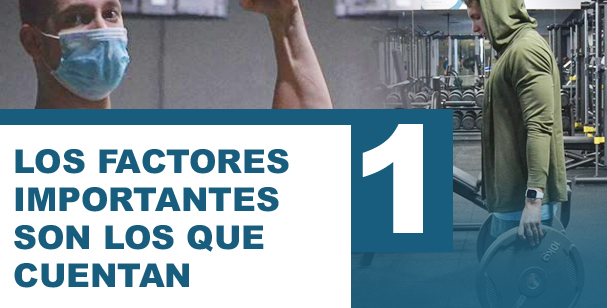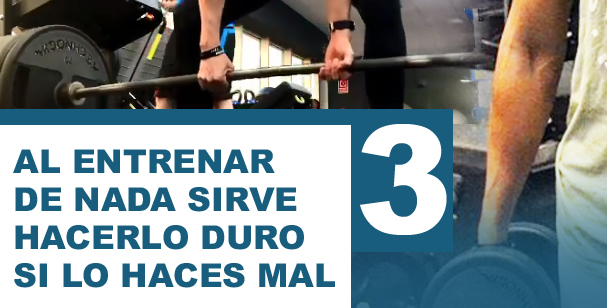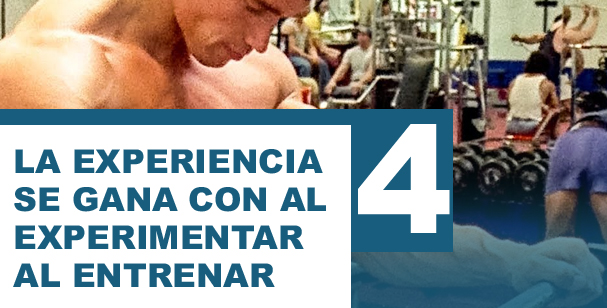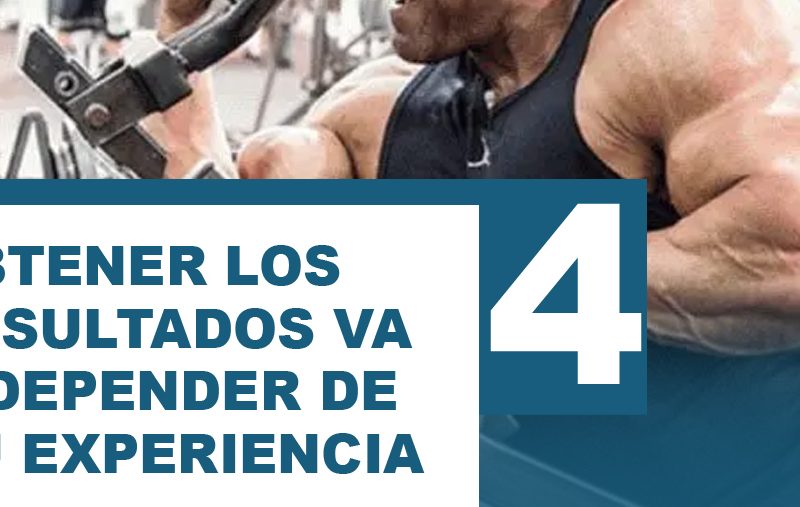In general, when you do hypertrophy work, you start to see that certain muscle groups do not grow, but why does this happen?
Sergio Molina explains to us in a master class on hypertrophy , what are the errors that prevent your muscles from growing … well, those muscle groups that you know you have a problem or feel behind …
As Raúl Carrasco spoke previously about how to work your back muscles, there are things to keep in mind when focusing on them and that is exactly what Sergio explains here.
The first thing is that you understand that this is part of your genetics, your person, your biological individuality and, in this context, you should never get frustrated.
Accepting things as they are is the first step; From there, the question is that you can optimize your training, so that your lagging or unbalanced muscles are at the level they deserve.
This starts to take on importance when you are intermediate or advanced. At this point it is emphasized that beginners need not worry, because they don’t even know what their strong muscle groups will be yet.
Over time, we all begin to feel things and begin to see which muscle groups are lagging behind or not responding as much to hypertrophy training, and that’s where the muscle groups come into play. techniques to apply.
Hypertrophy : The factors influence
Many times what happens here is that in certain circumstances you do not generate too many neural connections and, in the end, this depends on previous experience.
It depends on the motor experience you have and how it always occurs in hypertrophy, physiologically depends on the recruitment of motor units and the stress to which you submit that recruitment of motor units that you have done with training.
That is, it depends on the recruitment of motor units and the tension to which you submit those muscle fibers and those motor units that you have recruited.
But many times you cannot generate those neural connections because this is part of the process and you will notice that certain muscle groups do not feel them as much with certain exercises, as occurs especially in back exercises, in quadriceps exercises, squats.

That is, global exercises that do not allow you to spin very fine, do not allow you to feel the muscle much or take the stimulus you are looking for in that muscle group.
There are a number of mistakes that are made in this process of bringing a lagging muscle group to a higher level, and we mention them below.
Error 1: The obsession of the beginner
The first is to obsess as a beginner.
- If you are a beginner, dedicate yourself to training, to enjoy yourself.
- You will have time to work and stimulate these lagging muscle groups, because you still do not know what your strengths are, so do not worry, train and enjoy.
Error 2: Lack of context control
The second mistake is not controlling the context, and when you don’t, you start wanting to change the training and the solution isn’t really there.
- The solution is to pay attention to the context, because in the end we are not machines, we are human beings and factors influence.
- When working on hypertrophy, factors such as sleep count: if we sleep well or badly, diet: if we eat well or badly, emotional factors: if the girlfriend has left us, etc.
All that will affect your recovery and your response to training … for example, many times you do not respond so much to a backward muscle group or to hypertrophy in general, because basically you are not getting enough sleep or you are not controlling your stress levels …
If you are in an exam week or a busy week, that will affect your adaptations, therefore, check in context.
- You should be sleeping well.
- You should eat well and supplement correctly.
- You have to take into account your stress level.
- You have to take into account your level of focus.
- Work technical failure rather than muscle failure in certain instances.
- If you are not fully recovered, do not train.
- Take your digestion into account when training.
Anyway, control all that is invisible training and make sure that you optimize it so that your hypertrophy training is optimized.

Error 3: The training volume
Another mistake is to increase the training volume of this muscle group, without previously following a series of steps that will allow you to optimize the stimulus.
You cannot turn up the volume, if you do not guarantee that you are working efficiently.
The training volume for hypertrophy gives us the magnitude of the effect and, the intensity, the technique and that series of factors that occur in the exercise itself and in a specific series, will determine the stimulus and effect.
How we do the technique, if we standardize it, if we do it correctly, if we reach high strength characters, if we feel the muscle group, that will give us the effect we want.
But if you don’t optimize your training from the beginning and turn up the volume, what happens is that, no matter how much you turn up the volume, if the technique is not optimal, in the end you are not generating stimulation, you are generating fatigue.
Error 4: Not training enough
Another mistake is not training enough, for example;
- If you are doing a leg day and you only do 9 total sets including glutes, quadriceps, hamstrings, hamstrings, everything.
- Obviously your muscles are not going to grow because you are not generating enough stimulus and you are not optimizing the volume for hypertrophy .
You must understand that there are different thresholds: a minimum threshold and a maximum threshold and moving in the center of both is the efficient way to generate adaptations.
But if you don’t exceed the minimum threshold, you are obviously not getting the stimulus that is needed to grow your muscles as you want. Also, remember that you require amino acids and these are found in different versions.
Error 5: poor selection of exercises
Exercises are the way by which you are going to provoke the stimulus, however if you start from a poor selection of exercises, things will not go well to achieve muscle hypertrophy , both in your main muscles or the backward ones.
By not having an optimal stimulus, no matter how much you turn up the volume and no matter how much importance you give to the other factors, you will never progress.

Hypertrophy : what about periodization?
While all of this is relevant, the importance of performing exercises in training for hypertrophy has been somewhat neglected due to the advent of the novel concept, periodization.
We have debated a lot about periodization and why it is the most important element of hypertrophy training.
While there is definitely great merit in a gradual approach to training program, it should not become the determining factor of whether or not a program is efficient.
Linear, wavy, or pyramidal, it doesn’t matter!… in a nutshell, each and every one of these are methods of modifying the total workload (volume) throughout of a period of time …
If you ever hear claims about the perfect program, stay away from the coach who says this, as essentially there are many factors at play.
Essentially, you could have the most perfectly periodized training program known to man, but if its execution doesn’t work, it could also be rubbish!
To summarize, before addressing periodization; focus on performing the exercises correctly and knowing how to get to muscle failure or not.
If you focus on technique in each repetition, you will be having a greater margin of error in your training, which will allow you to obtain greater gains from hypertrophy
Obviously this would work for intermediate to advanced, but not always for high performance bodybuilders who have other canons of progress and other goals for each training session.
Hypertrophy: what about the effort?
At this point, effective execution and the correct selection of exercises are crucial to a good hypertrophy program, but perhaps a key ingredient is missing: “good old-fashioned hard work.”
It takes all three elements (execution, selection and effort) present to obtain a maximum training response. In fact, you need execution and selection first to qualify to use effort!
You see, most people complete 200% workouts with 50% reps, which means they go nuts for an hour with a ton of unnecessary sets and outrageous resistance exercises that mean “zero” stimuli.
In any gym we see a kid with 10/10 for effort, but a modest 2/10 for concentration and effort.
- The actual effort is what counts, no matter how much effort you seem to be putting in and this relates to everyone, it is not an individual factor.
- More is Better when training is not related to Better is More when training to achieve hypertrophy in the most effective way.
The goal is not to “win” the training, the goal is to progress and have fun along the way. And, if you can do this more effectively and in less time, then it would be foolish not to.
If you do not experiment, you do not progress
In a sport known more for its physical strength than its brain, Arnold Schwarzenegger was an enigma; He was one of the best bodybuilders of all time and he did it not only by working, but also by thinking about everyone.
Arnold told us at one of the fairs where he participated in a meeting with MASmusculo that “to be successful in bodybuilding or in any sport, you need to learn to think”.
You have to understand what you are doing… find out what really works for you…
Sure you have to train hard, but it won’t do you much good unless you also train smart to achieve hypertrophy .

Arnold knew that each of our bodies was different and therefore each will respond differently to training.
For those of us who study bodybuilding in depth, working smarter meant learning the “training principles” that apply to all of us and then figuring out how to apply those principles in the way that works best for the individual.
Smart hypertrophy training involves learning about these differences and adapting training accordingly.
For example, in his book, The Bodybuilding Encyclopedia, Arnold describes how he could train his chest and lats as intensely as he could, but his results stayed better when he combined the two.
From his choice of exercises to how many times a day he trained, he used a scientific mindset to find what worked best for him.
YES, we put it in a simple phrase “experimentation”, which is what allows you to progress, stop or go backwards, as long as you follow those principles and some tips, among which are those cited by Sergio Molina.
If you train hard, stay consistent, but avoid mistakes, it’s just a matter of experimenting and focusing on the important things.


